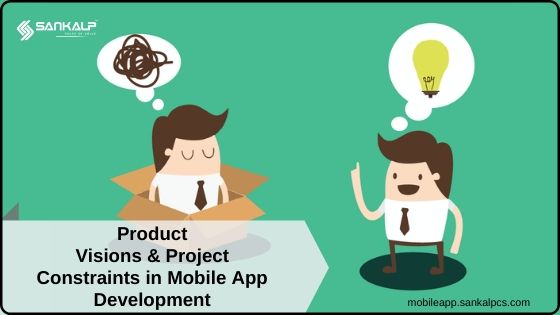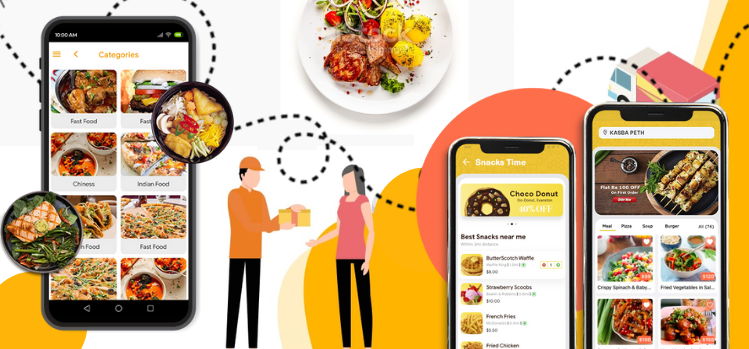Mobile apps are built for delivering innovation and bringing novelty to users. The ultimate goal of mobile app developers is to build a one-of-a-kind app that changes the user experience for the better. To achieve this, there is an evident conflict between the vision of the product and the constraints that the mobile app development project faces.
Any mobile app development company is expected to tackle this tussle by weighing the product ideas against the project constraints. With the support of app developers, the client envisions specific ideas on how a mobile app should turn out at the end of the process. Now, the app developer faces challenges in meeting these expectations when difficulties arise at multiple steps of the process.
To strike a balance between the expectations and the difficulties, the mobile app development process should always begin with defining the product ideas clearly. At the same stage, the likeliest of problems should be identified well in advance.

Defining the Product Ideas in Mobile App Development
There are dozens of ideas that flow through our minds while defining the vision of a mobile app product. The best way to set expectations is by using the MVP technique. The minimum viable product approach is a process of pre-defining the product with sufficient features aimed at satisfying the early adopters. With this technique, the feature set for your product can be clearly understood.
Another factor that plays a key role in determining product vision is targeting the app audience. Based on the persona of targeted users, a flow of information can be framed in the idea development process. The framework can eventually be utilized for creating a systematic flow of functions and features in the latter stages of mobile app development.
Identifying the Possible Challenges
There are always going to be some constraints in any mobile application development project. In native app development, most app developers face challenges with respect to the retention rate, UI/UX build, and limited user engagement. The process of cross-platform app development is also riddled with issues on design approach, navigation control, and scaling.
Scope, schedule, and costs are observed as the three critical project constraints in mobile app development. Unspecified goals distort the scope of the project at every stage. Unorganized and delayed deliverables keep pushing the development timeline further. And, all this comes at increasing costs, forcing the project to overstep its budget.
Now, let’s find some solutions to equalize these problems with the anticipated results.
3 Effective Ways to Evaluate Mobile App Development Project Ideas
Complex planning and research go into evaluating the visions of the product. While the product ideas could be as innovative as possible, but only the practical ones needed to be finalized. For determining the project idea, the mobile app makers need to go further with these three steps.
- Value proposition: The idea being explored should have the potential to simplify the targeted task for users. Ensure the value proposition of the product idea is unique, and see estimate the RoI to see if it is worth spending money on.
- Market feasibility: Identify the target userbase and analyze their past activities in the relevant app marketplace. Be clear with the market segment where your app would perform. Strategize the feasibility of your product by comparing all the viable markets with each other.
- Competitor assessment: Do extensive research on the competition landscape. Your product may not be new completely, and there could be another company offering a similar mobile app. If you have some competitors in mind, you can target them by evaluating your product ideas on the basis of their shortcomings.
With these three stages, the evaluation of your product ideas is complete. To be precise, you can choose to create a Product Requirements Document (PRD) and optimize the evaluation.
The Role of Product Requirments Document
To develop mobile apps productively, a substructure called the PRD is crafted by putting in a lot of thoughts and efforts. This document is a substructure that includes the complete set of requirements for the end-to-end development of mobile apps.
Product Requirements Document is the first step after the evaluation of product ideas is complete. This document ensures that the ideas can be actualized to their fullest potential. While PRD can be ambiguous in some projects, it is still useful to develop user flow, justify visions to stakeholders, enlist technical requirements, and convey the business logic behind the project.
Keep an Alert Eye on These Project Constraints
For developing iOS or Android applications, no difficulty should be ignored. No matter how small the problem could seem, it is important to address it at the development stage and avoid negative post-launch consequences. Here’s how you’d mainly face these project constraints but would eventually find a fix for them.
Constraints on Business Feasibility
After setting up the business objectives of your app development project, you will face trouble in accomplishing each of them. The mobile application to be built must fulfill all the objectives.
Here are some pro tips on how to ensure the mobile app satisfies the business objectives:
- Establish a clear definition of the business goal
- Ensure the app offers an easy solution to an existing problem
- Focus on how the app becomes a viable solution for customers
- Plan the revenue model precisely
- Create the feature list to reach the desired product
- Consider some expected delays and set the timeframe for project completion accordingly
It is possible to balance The business-based constraints of the project, with the product ideas by undertaking the above-mentioned tasks.
Technical Constraints In Mobile App Development
Moving on, the most critical project constraints in mobile app development are always technical in nature. While there is no certainty on the kind of technical constraints a project may encounter, here are the ones commonly faced by mobile app developers.
- Operating System Lifecycle: Decide which operating system would your app be fit for. You can consider cross-platform development and get the best app for Android as well as iOS operating systems.
- Devices to Support: Custom app development can provide a solution where the product works on all platforms and operating systems. But, for it to work on all devices, you need to use process optimization and ensure the mobile app uses the least amount of resources to run. This way, it finds compatibility with a broader, diverse range of mobile devices owned by users.
- Timeframe: You can lose time in coding, creating responsive designs, developing new features, and testing the versions. To set the right timeline for the project, break down the tasks into sub-tasks and assign the maximum time for them. Allocate resources based on the complexity of the tasks.
- Budget: To get the perfect budget estimate, understand the challenges faced by industry competitors. Partner with experts and organizing the expenditures based on the prioritized tasks.
At one stage, the project ideas will be well-evaluated. Then, the business feasibility would be checked and curated. And soon, the technical constraints will be dealt with effectively as they occur. The key to balance these stages will come down to make the right decisions.
Right Decision-Making – The Balancing Act
From ideation to actualization, there are going to be several options coming in the path of mobile app development. The right choices made in these steps can certainly deliver a product not compromised on functional value and data security.
In most cases, you’d have to make the right decision on:
Why are we building the app?
Imagine the app with the desired features and determine where the particular app or its features stand against the needs of users.
Are there any alternatives to the features?
Research the existing apps and find alternatives that save time and effort without compromising on the benefit.
How to get to market quicker?
Keep adjusting the resources to optimize the timeframe, and create a comprehensive PRD that accelerates the time to market.
If there is a bit of skepticism regarding the choices made and you’re not sure if they are the right ones, consider partnering with an expert mobile app development company. Services by a leading professional mobile app developer will guide you through these stages seamlessly, and help you set the balance between the expectations and the challenges easily.







Incredible points. Sound arguments. Keep up the amazing effort.
[…] Technologies have led to the evolution of the retail business. Many challenges retailers use to face before are now under the IT domain. This aspect holds for the business’s customers as well. Now, your retail store clients do not have to seek specific items in different city stores or be concerned about payment modalities. Mobile app development is now focused on crafting exceptional mobile retail store apps. […]